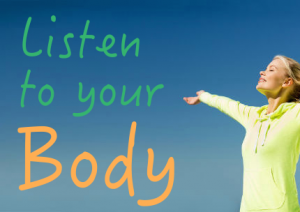
“Listen to your body” has turned into a popular catchphrase in health, wellness, and mind/body circles. Yoga teachers say it during class, dieticians may say it as a way of helping you figure out what kind of food (and how much) you should be eating, and it’s a favorite slogan of wellness advocates like Deepak Chopra and Oprah.
But what does “listen to your body” really mean? In some ways, it sounds simple enough. When you’re tired, sleep. When you’re hungry, eat. When you’re injured or sore, take a break from exercise. But what about when your body’s telling you to eat a whole box of chips or cookies?
Or when you’ve gained a little weight and you think it must be your body telling you to go on a month-long juice fast? Or when your blood sugar is so messed up that you never feel full, even after a big meal. Listening to your body, in situations like these, may not be as straightforward as it seems.
Unfortunately, most of us don’t have the tools to evaluate what our body is really telling us. So we simply react to every unpleasant or unwanted feeling we have, don’t feel very well afterwards, and then conveniently forget the next time we find ourselves in the same situation or with the same feeling.
What I have learned about understanding what your body is trying to tell you is that it takes experience, commitment, and mindfulness.
It requires paying attention and asking yourself questions—talking and listening to yourself honestly—over long periods of time. Only by doing this can we know what our bodies need and provide it.
When we only tune in randomly, or when one sensation or desire is particularly strong, we simply end up giving into the myriad number of thoughts, feelings, desires, or cravings we may have at any given time, which may or may not be what our body actually needs. We react, instead of respond. When we give in to our cravings for sugary food, we’re reacting. When we recognize that our body needs energy, and we choose to provide it in the nourishing form of fruit rather than M&M’s, we’re responding.
Truly knowing the difference between these two—reacting and responding—requires paying regular, close attention to our sensations, feelings, moods, and energy levels. When we pay attention to and understand intimately the way we feel throughout the day—before, after, and while eating certain foods; before, after, and during exercise; when we’re at work; when we’re under stress; when we do or don’t sleep enough; when we sleep too much, and in the many other situations we all experience—only then can we feel truly confident about “listening to our body” and knowing what it’s trying to tell us.
Ready to get started? Here are some tips to practice checking in with your body throughout the day:
Stop reacting: Whether it’s craving a food that’s bad for you, or immediately saying “yes” to your friend who invites you out for dinner or drinks, we all make decisions without checking in with ourselves first. Next time a situation like this arises, take a few minutes to yourself to check in with your body—as it may have a different answer than the one you would have given in the moment!
Ask yourself how you feel: Do this every moment you can. When you wake up in the morning, after your breakfast, in the car on the way to work, before you sit down at your computer. Ask yourself again and again and then LISTEN.
 Keep a diary: Sometimes it’s easier to find patterns in moods and feelings when you have a record of them, and keeping a diary or journal is a great way to do this. Write down how much sleep you got and how you felt.
Keep a diary: Sometimes it’s easier to find patterns in moods and feelings when you have a record of them, and keeping a diary or journal is a great way to do this. Write down how much sleep you got and how you felt.
What you felt like before and after exercise, and what time you got a headache and what you ate beforehand. Then use it as a reference. You can write about any and everything, or you can focus more on areas you’re working on: diet, sleep, exercise, moods, etc.
Do a daily “body scan”: This is a great technique to use before bed. Lie down in a relaxed position and bring your attention to the top of your head, noticing any and all feelings and sensations that may be there.
After a few moments, slowly move your awareness down and around your face, the back of your scalp, your neck, and your shoulders, and down your entire body, spending a few moments on each location to notice how each part of you feels. You can stop after one time through, or you can continue by scanning from the tips of your toes back up to the top of your head.
Check your breath: Our breaths contain so many clues as to the state of our body. Fast and shallow? We may be stressed or anxious. Slow, deep, and through the nose? Our bodies are probably pretty relaxed. Take the time to check in with your breath throughout the day—you may be surprised at what you learn!
The truth is, we all already have everything we need to be healthy, happy, and wise. All we need to do is start listening to ourselves—closely, attentively, and lovingly. With some time and practice, we can all learn to give ourselves exactly what we need!
-Teresa Manring
Teresa is a freelance writer and yoga instructor currently studying in Sri Lanka. She has over 600 hours of yoga teacher training in Hatha Yoga, Vinyasa Flow, and Yoga Therapy. She believes sleep, self-love, and the breath are the keys to health and joy.

